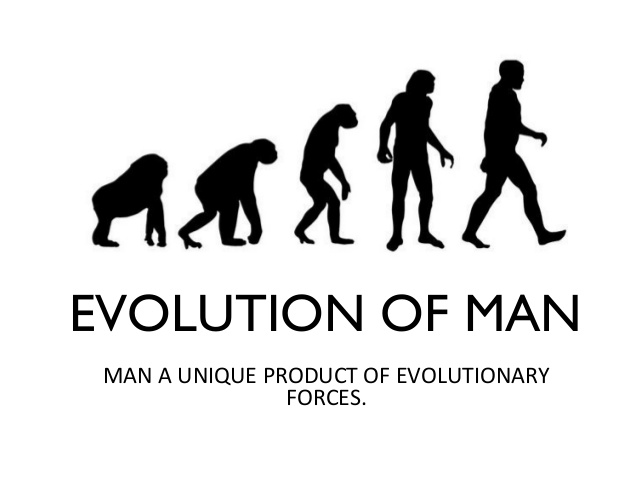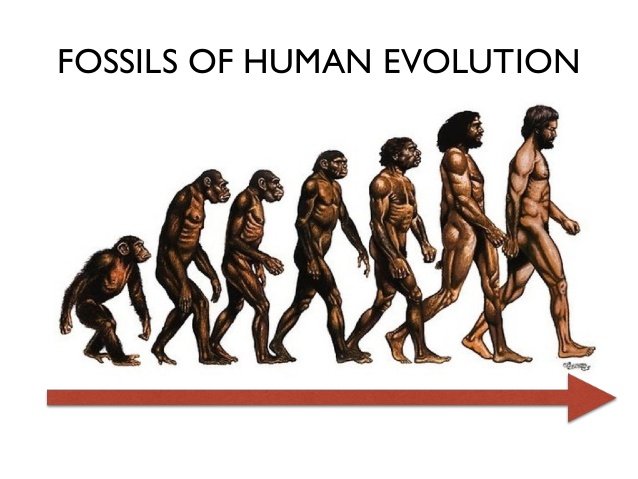HUMAN EVOLUTION
 Human evolution is the evolutionary process that led to the emergence of anatomically modern humans, beginning with the evolutionary history of primates – in particular genus Homo – and leading to the emergence of Homo sapiens as a distinct species of the hominid family, the great apes.
Human evolution is the evolutionary process that led to the emergence of anatomically modern humans, beginning with the evolutionary history of primates – in particular genus Homo – and leading to the emergence of Homo sapiens as a distinct species of the hominid family, the great apes.
The study of human evolution involves many scientific disciplines, including physical anthropology, primatology, archaeology, paleontology, neurobiology, ethology, linguistics, evolutionary psychology, embryology and genetics.[1] Genetic studies show that primates diverged from other mammals about 85 million years ago, in the Late Cretaceous period, and the earliest fossils appear in the Paleocene, around 55 million years ago.[2]
Within the Hominoidea (apes) superfamily, the Hominidae family diverged from the Hylobatidae (gibbon) family some 15–20 million years ago; African great apes (subfamily Homininae) diverged from orangutans (Ponginae) about 14 million years ago; the Hominini tribe (humans, Australopithecines and other extinct biped genera, and chimpanzee) parted from the Gorillini tribe (gorillas) between 9 million years ago and 8 million years ago; and, in turn, the subtribes Hominina (humans and biped ancestors) and Panina (chimps) separated about 7.5 million years ago to 5.6 million years ago.
The modern theory concerning the evolution of man proposes that humans and apes derive from an apelike ancestor that lived on earth a few million years ago. The theory states that man, through a combination of environmental and genetic factors, emerged as a species to produce the variety of ethnicities seen today, while modern apes evolved on a separate evolutionary pathway. Perhaps the most famous proponent of evolutionary theory is Charles Darwin (1809-82) who authored The Origin of Species (1859) to describe his theory of evolution. It was based largely on observations which he made during his 5-year voyage around the world aboard the HMS Beagle (1831-36). Since then, mankind's origin has generally been explained from an evolutionary perspective. Moreover, the theory of man's evolution has been and continues to be modified as new findings are discovered, revisions to the theory are adopted, and earlier concepts proven incorrect are discarded.
Evolution Of Man - Concepts in Evolutionary Theory
The currently-accepted theory of the evolution of man rests on three major principles. These principles hinge on the innate ability which all creatures have to pass on their genetic information to their offspring through the reproductive process. An alternative explanation for homology is a common designer. According to this reasoning, the similarities in anatomical features between species point to a blueprint used by a Creator/Designer.
The first tenet is microevolution, the occurrence and build-up of mutations in the genetic sequence of an organism. Mutations are predominantly random and can occur naturally through errors in the reproductive process or through environmental impacts such as chemicals or radiation.
The second tenet of evolution is natural selection. Natural selection is a natural mechanism by which the fittest members of a species survive to pass on their genetic information, while the weakest are eliminated (die off) because they are unable to compete in the wild. Natural selection is often termed "survival of the fittest" or "elimination of the weakest."
The third tenet is speciation, which occurs when members of a species mutate to the point where they are no longer able to breed with other members of the same species. The new population becomes a reproductively isolated community that is unable to breed with its former community. Through speciation, the genes of the new population become isolated from the previous group.
Evolution Of Man - Scientific Evidence
The theory of evolution of man is supported by a set of independent observations within the fields of anthropology, paleontology, and molecular biology. Collectively, they depict life branching out from a common ancestor through gradual genetic changes over millions of years, commonly known as the "tree of life." Although accepted in mainstream science as altogether factual and experimentally proven, a closer examination of the evidences reveal some inaccuracies and reasonable alternative explanations. This causes a growing number of scientists to dissent from the Darwinian theory of evolution for its inability to satisfactorily explain the origin of man.
One of the major evidences for the evolution of man is homology, that is, the similarity of either anatomical or genetic features between species. For instance, the resemblance in the skeleton structure of apes and humans has been correlated to the homologous genetic sequences within each species as strong evidence for common ancestry. This argument contains the major assumption that similarity equals relatedness. In other words, the more alike two species appear, the more closely they are related to one another. This is known to be a poor assumption. Two species can have homologous anatomy even though they are not related in any way. This is called "convergence" in evolutionary terms. It is now known that homologous features can be generated from entirely different gene segments within different unrelated species. The reality of convergence implies that anatomical features arise because of the need for specific functionality, which is a serious blow to the concept of homology and ancestry.
Additionally, the evolution of man from ape-like ancestors is often argued on the grounds of comparative anatomy within the fossil record. Yet, the fossil record indicates more stability in the forms of species than slow or even drastic changes, which would indicate intermediate stages between modern species. The "missing links" are missing. And unfortunately, the field of paleoanthropology has been riddled with fraudulent claims of finding the missing link between humans and primates, to the extent that fragments of human skeletons have been combined with other species such as pigs and apes and passed off as legitimate. Although genetic variability is seen across all peoples, the process of natural selection leading to speciation is disputed. Research challenging the accepted paradigm continues to surface raising significant questions about the certainty of evolution as the origin of man.
Evolution Of Man - The Scrutiny
The theory concerning the evolution of man is under increased scrutiny due to the persistence of gaps in the fossil record, the inability to demonstrate "life-or-death" determining advantageous genetic mutations, and the lack of experiments or observations to truly confirm the evidence for speciation. Overall, the evolution of man pervades as the accepted paradigm on the origin of man within the scientific community. This is not because it has been proven scientifically, but because alternative viewpoints bring with them metaphysical implications which go against the modern naturalistic paradigm. Nevertheless, a closer examination of the evidence reveals evolution to be increasingly less scientific and more reliant upon beliefs, not proof.
Congratulations @carlsmith7! You have received a personal award!
Click on the badge to view your Board of Honor.
Do not miss the last post from @steemitboard:
SteemitBoard World Cup Contest - Quarter Finals - Day 2
Participate in the SteemitBoard World Cup Contest!
Collect World Cup badges and win free SBD
Support the Gold Sponsors of the contest: @good-karma and @lukestokes
Congratulations @carlsmith7! You received a personal award!
You can view your badges on your Steem Board and compare to others on the Steem Ranking
Vote for @Steemitboard as a witness to get one more award and increased upvotes!